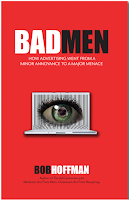For the first time ever, the advertising industry is getting data about things that up until now were the province of speculation and ideology.
We’re starting to get a glimpse of how consumers actually behave when confronted with advertising. Not how they say they behave; not how we think they behave; not how they behave under controlled conditions, but what they actually do at home in front of the tv when they see an ad. The picture we are getting is challenging some of Madison Avenue’s most cherished and widely held beliefs.
The unlikely source of this data is TiVo, the device that was supposed to kill the advertising industry. It may kill it yet, but for a whole different reason.
It may turn out that TiVo demonstrates what some of us have secretly feared for years -- that the advertising industry has been squandering its clients’ money with self-serving and self-indulgent practices that do more to promote ad agency objectives than client products.
For well over a decade, the process of creating advertising has been becoming more and more arcane. Ad agencies have re-invented themselves, not as grey-flannel hucksters, but as interpreters of culture; as commercial anthropologists and ethnographers. One of America’s hottest agencies has someone called “Group Director, Culture and Cognitive Studies”.
This move away from salesmanship and toward psycho-sociology has been both attractive and repellent to our clients. On one hand marketers have become the biggest cheerleaders and chief advocates for account planning, communications planning, and other types of “soft” marketing science that supposedly interpret consumer beliefs and behaviors. On the other, they continually harp at us that ads aren’t as effective as they once were. It seems that they haven’t yet connected the dots. But TiVo may change all that.
When you are in playback mode, the TiVo box in your home knows what you are watching at all times. It can tell what you skip past and what you stay for. And here’s what it seems to be telling us: When it comes to advertising, you are skipping the good stuff and staying for the junk. (see Amazing Data from TiVo, and this from Business Week.)
In the advertising world, the good stuff is considered to be the stuff that wins the awards, gets featured in trade publications, wins new business for ad agencies, and big jobs for its creators. The junk is the stuff with 800 numbers, big prices, and not a hint of Cultural and Cognitive Studies.
The first reports we are getting from TiVo say that the commercials that people are staying for most and skipping least tend to be direct response and retail commercials.
The junk.
This challenges one of advertising’s sacred cows. Agencies are always telling their clients that in order to attract viewers, advertising needs to reward them. This is the argument for advertising as entertainment (see Wait A Minute). The argument goes like this: people have too many entertainment options. If we are going to engage them in our ads, we have to be as entertaining as the programming. The hidden agenda here is that everyone in advertising would really rather be in the entertainment business (full disclosure -- so would I) and is always looking for a reason to re-define advertising as entertainment. TiVo is teaching us that either this argument is wrong or Bowflex commercials are way more entertaining than anyone imagined.
This finding has serious strategic implications for advertisers. The key difference between most direct response and retail advertising, and most brand advertising, is that the DR and retail industries use advertising to affect change in behavior. They want you to pick up the phone, or go to the store, and they focus their ads on giving you specific, clear reasons to do so.
The brand advertising model, however, has a different objective. It tries to change your attitudes. It wants to affect your beliefs.
Many in the ad community will wring their hands and pull their hair out trying to understand the TiVo results. How can that crap with the 800 number be more effective than our brilliant, award-winning, focus-group-approved brand campaign?
To some of us, however it is not surprising at all.
In my book, The Ad Contrarian, I explain that one of the three key principles of advertising is that advertising is most effective when it is focused on changing behavior, not attitudes. Attitudes are almost impossible to change – ask any neuroscientist or psychologist.
Retailers and DR practitioners aim to change behavior, brand advertisers aim to change attitudes. Retail and DR wins. End of story.
Does this mean that brand advertisers should have 800 numbers and flying prices in their ads? No. But it does mean their advertising should focus on product-related messages. That's how you build a brand.
Apparently, all the ethnographic and anthropologic chattering may not be doing a thing to make advertising more effective (see Salesmen and Sociologists).
Now that reliable data is becoming available you’d think that ad agencies would start to reconsider their prejudices. They won’t. Their beliefs are too baked into their DNA for them to even consider that they may be operating under false premises. Agencies will continue to ignore any data that suggests that consumers have quite enough entertainment, thank you, and respond best to ads that tell them something interesting about products.
SUBSCRIBE TO THE AD CONTRARIAN
Subscribe to:
Post Comments (Atom)





No comments:
Post a Comment